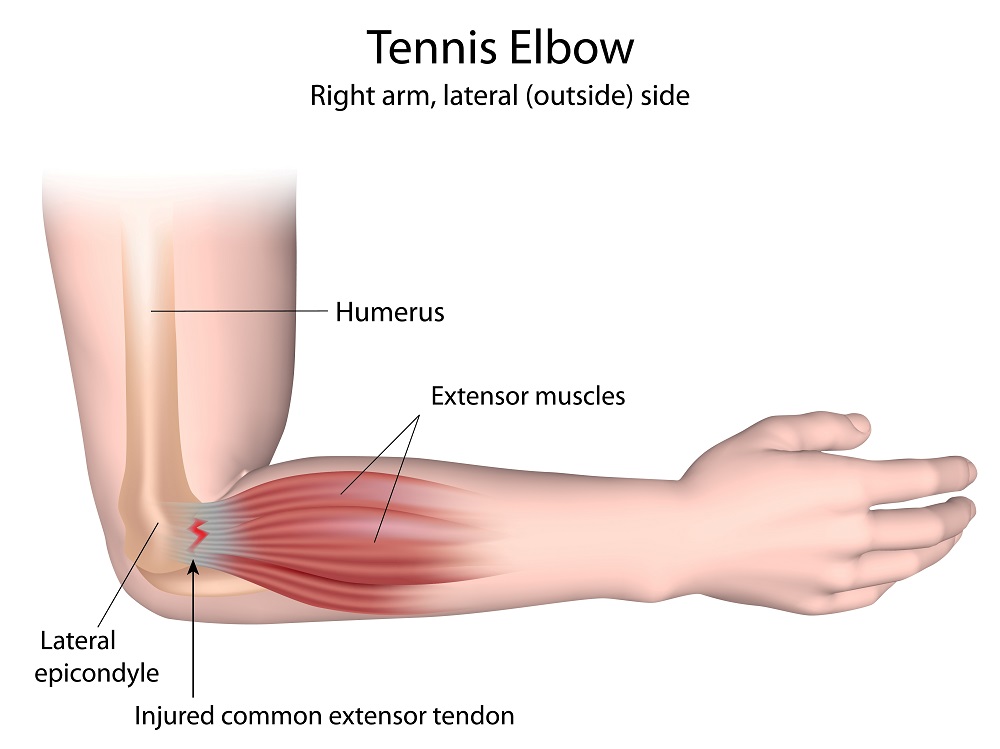Signs for tennis elbow might include:
- Recurring pain on the outside of the upper forearm below the bend of the elbow
- Pain when twisting forearm or wrist
- Pain when lifting or bending the arm
- Pain radiates from the outside of the elbow into wrist and forearm
- Holding a coffee cup, writing, gripping small objects or shaking hands may be painful
Tennis elbow usually occurs in the dominant arm (right arm in right-handed person), sometimes also in the non-dominant arm or both arms.
The condition is an overuse and muscle strain injury. In tennis players, hitting tennis balls over and over again may result in tiny tears in the forearm tendon attachment at the elbow (e.g. if the player repeatedly uses backhand stroke with poor technique). Golfers sometimes get golfer’s elbow: If they play golf frequently, the inside of the arm might be affected.
But not only tennis and golf players develop tennis elbow. It also often occurs by doing any form of activity that involves repeatedly twisting the wrist and using the forearm muscles, e.g. by doing sports, gardening, plumbing, chopping, typing, etc.
If tennis elbow is not treated, the condition may lead to chronic pain, particularly when gripping or lifting objects. If the arm is used too strenuously before the elbow has healed, the problem might get worse.
The most effective way to treat the condition is to find the source of the pain and eliminate it. In quite a few people, tennis elbow then gets better on its own. However, if the affected person continues the activity that caused the pain in the first place, it’s unlikely that the pain disappears.
Self-care
- Avoiding activities that aggravate the elbow pain
- Pain relievers, e.g. ibuprofen
- Applying ice on the elbow (for 15 minutes, three to four times per day)
- Avoiding repetitive wrist motions
- Using the right technique for sports (e.g. tennis) work or other activities
Nonsurgical therapy
If the self-care measures don’t help, the doctor might recommend physical therapy in which the muscles of the forearm e.g. are gradually stretched and strengthened. In addition, it may be helpful to reduce stress on the injured tissue by improving the tennis technique or changing the movement that caused tennis elbow. Experts in the respective field can suggest special techniques. To reduce stress on the injured tissue, it’s also possible to wear a forearm brace or strap.
If the patient continues to suffer from severe pain and cannot use his/her arm, an injection of a steroid into the painful area of the elbow might ease the pain. Another option for treating tennis elbow is shock wave therapy: Waves are passed through the skin to relieve pain and promote movement in the area that is affected.
Surgery
If the condition hasn’t improved after six to twelve months, surgery might be an option to remove damaged tissue. After operation, it’s essential for the patient to do the rehabilitation exercises.
Preventive measures
It’s not always possible to prevent a sudden overuse of the arm. But increasing the strength of the forearm muscles and avoiding twisting movements may help a lot. A physiotherapist can recommend the best exercises, also in case of work-related tennis arm. And a coach might suggest better techniques to avoid tennis elbow by playing tennis, golf, etc.


